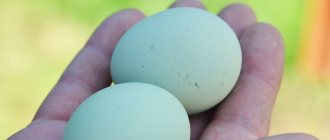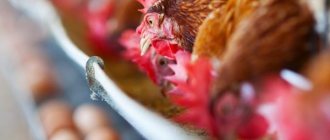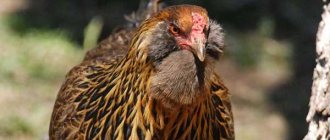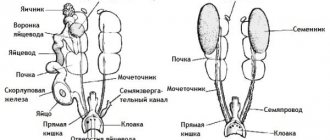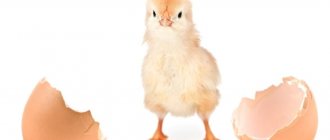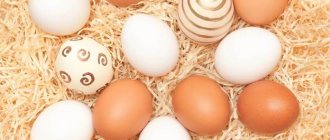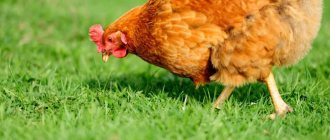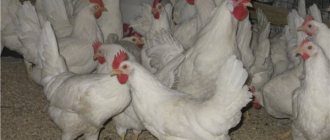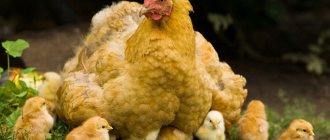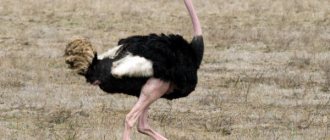1 885
no comments yet
0
Author:
Rasskazov Pavel.
Reading time: 4 minutes
Having reached a certain age, chickens begin laying eggs. The beginning of egg laying depends on feeding, the condition of the bird, climatic conditions, the breed and orientation of the chickens. There are three important classifications: meat, meat-egg and egg (laying hens).
Indicators of egg production of birds
Officially, there are currently three types of chicken breeds: egg, meat and egg and meat. If it is necessary to obtain eggs in large quantities, you should choose egg or meat-egg breeds. They are capable of producing up to three hundred and twenty units of production per year.
- in a day. A chicken of a suitable breed, subject to basic rules of husbandry and nutrition, can lay up to one egg per day. However, there are cases where females lay more eggs. Much depends on the season;
- for a week. The most productive breeds, such as the Leghorn, can lay three to seven eggs per week. But here, too, productivity completely depends on the season and living conditions;
- monthly. Egg and meat-egg chickens typically produce ten to thirty eggs per month. Often the lowest rates are observed in December, February and autumn. Egg production increases with warmer days and longer daylight hours;
- year. Chicken productivity is often judged by the number of eggs they lay each year. Thus, the best breeds are bred annually from three hundred to three hundred and twenty, some much less.
As a rule, in winter, productivity indicators drop and chickens begin to behave according to a certain schedule. In some cases, they stop lying down completely.
You can compare the masonry data of the most popular types in the table below.
| Types of races | Productivity (per year) | Weight of one egg (in grams) |
| Leghorn | Up to 300 eggs | 55–65 |
| Loman Brown | Up to three hundred twenty | 60-65 |
| Hysex | Up to three hundred ten | 60-65 |
| Russian White | About two hundred | 55-60 |
| High Line | Up to three hundred fifty | 60-65 |
Most often, the most productive hens begin laying early, but after the first year of active laying, productivity decreases significantly. In this case, the birds are usually slaughtered. Therefore, when purchasing, it is necessary to determine the age of the chicken, since the younger the laying hen, the more eggs she can lay.
Ameraucana
The breed was created in 1976 by the American Poultry Association. To obtain them, tailless representatives of the Araucana breed were crossed with local egg-laying chickens. The result is a productive layer that produces blue eggs.
Peculiarities:
- Egg production (per year): 210-260 pcs. (60-65 g).
- Testicle color: blue.
- Laying hen weight: 2.6 kg.
- When they start laying eggs: 180-240 days.
A characteristic feature of the Ameraucana is the presence of sideburns and a goatee. The comb has the appearance of a pod; in chickens it is almost invisible. The tail is well feathered, unlike the related Araucana breed. Colors may vary.
INTERESTING! The color of the egg shell is necessarily blue. If it is pink, beige or white, the chickens are not Ameraucanas.
Can a hen lay eggs without a rooster?
There is a misconception that the rooster needs to be carried by the chickens. Many people believe that without it this is impossible. However, it is not.
The only drawback is that the eggs will not be fertilized and, therefore, it will be impossible to get offspring from them. Nevertheless, some farmers note that in the absence of a rooster, the productivity of the bird decreases, and with its appearance it increases. However, this fact has no scientific basis.
For continuous egg production, it is enough to keep only chickens in the house.
Pushkinskaya
The breed was obtained in the city of Pushkin, from where it took its name. It was approved only in 2008. There are two lines of this breed: selection from St. Petersburg and Sergiev Posad. They differ in color and appearance.
Peculiarities:
- Egg production (per year): 210-260 pcs. (70-75 g).
- Testicle color: white.
- Laying hen weight: 2.5 kg.
- When they start laying eggs: 120-150 days.
Pushkin chickens are the most suitable breed for private households. They are unpretentious and begin to lay eggs early. The egg is very large, weighing about 70-75 grams. Chickens are unpretentious to air temperature and diet.
IMPORTANT! The color of laying hens bred in St. Petersburg is variegated, black and white, with a pink comb. Chickens obtained in Sergiev Posad are darker, gray-black, with a leaf-shaped comb.
Ways to increase egg production
In order for chickens to continue laying eggs after reaching sexual maturity, it is necessary to provide them with the necessary living conditions. However, in some cases, performance may drop for no apparent reason. Then you can apply the following recommendations:
- Increase the space in your poultry house. Close working conditions can have a negative impact on productivity. Therefore, you should either increase the space in the chicken coop itself, or move the excess birds to another chicken coop;
- choose the right breed. The main factor contributing to good productivity is the selection of the most preferred types of chicken;
- to monitor the food dose. Too much or too little food in a bird's diet can also negatively affect egg production. If chickens eat eggs, pay attention to their diet. Therefore, you need to carefully monitor the amount of food.
- Restore the herd. Older hens rapidly decline in egg production each month and year, and flocks require supplementation in the form of young chicks;
- introduce mineral and vitamin supplements. Not all chicken feed mixtures are well balanced. In some cases, nutritional deficiencies may occur. When cooking eggs, it is recommended to add chalk and eggshells to your basic diet. If chickens are deficient in micronutrients, they may lay eggs without shells;
- Extending time spent in daylight. Chicks respond very well to light. Long daylight hours signal that the stack should be active. Therefore, it is worth having electric lighting in the chicken coop and turning off the lamps at night;
- Treatment of common diseases and parasites. Infections and the presence of helminths in the body of chickens negatively affect performance;
- improve temperature and humidity conditions. Chickens do not lay eggs in extreme cold or heat. Therefore, the poultry house must be well insulated in winter, ventilated in summer and provided with access to outside air. When setting up a chicken coop, it is important to provide comfortable nests and perches. Birds must be able not only to lay eggs, but also to rest - excessive load exhausts the bird and they will have to be sent to slaughter earlier.
Some breeders try to increase chicken productivity by using stimulant chemicals. Their use is not recommended due to the possible depletion of the bird’s body against the background of an artificial increase in egg production.
Beneficial periods
Poultry performance is affected by weather conditions, seasons, temperature and atmospheric conditions, and molting periods.
Expert opinion
Sadchikov Nikolay Alekseevich
Veterinarian ornithologist
Ask a Question
The period from May to October is considered to be the most favorable for high productivity. This time period is associated with long daylight hours, high temperature, stable pressure, and the presence of greens and vegetables.
In the fall, chickens may suspend their egg production for 2-2.5 months due to seasonal molting. During this period, chickens must be provided with additional vitamins and minerals.
Felucene is an effective and harmless additive for maintaining the health and productivity of birds
More details
Gammatonic: an effective vitamin feed supplement for vitamin deficiency
Read
Trivit for the prevention of hypovitaminosis and diseases caused by a lack of vitamins A and D
About the drug
How to use calcium borogluconate to treat poultry
Look
Review of the best egg breeds
The most productive chicken breeds today are artificially bred and industrial crosses. Both are very popular among amateur gardeners and are actively bred in poultry farms due to their high profitability.
- Loman Brown. This is the most popular trading cross. Loman Brown chickens have large brown eggs and a long laying period, up to eighty weeks. Moreover, each chicken is capable of laying more than three hundred eggs per year;
- Hysex. These crosses were bred in 1970. Representatives of the breed are capable of producing more than three hundred large eggs per year, tolerate fungal, viral and bacterial infections well, have a high survival rate and are unpretentious in maintenance. Currently, two varieties have been developed: Hisek White and Hisek Brown;
- Isa Brown. Chickens are well adapted to all conditions and acclimatize quickly. They lay up to three hundred and twenty large brown eggs per year and do not require much care. At the same time, for normal life and laying eggs, they need a little more than one hundred grams of food per day;
- High line. This bird easily adapts to any living conditions and tolerates changes in temperature well. Moreover, they are capable of laying up to three hundred and fifty eggs per year;
- Livorno. Representatives of this species are small in size, so they do not need little food. At the same time, they produce more than three hundred eggs per year and have an aesthetic appearance. The disadvantage of Leghorn chickens is a rapid decline in productivity - already a year and a half after the start of egg laying.
Industrial crosses usually have excellent properties and characteristics, but it is impossible to repair them yourself. This is due to the fact that when trying to get offspring, you can get chicks from several different breeds that were used in the crossing. Therefore, young animals can only be purchased from farms specializing in poultry farming.
Zagorskaya salmon
A domestic breed that was bred in 1955 at the Zagorsk Poultry Institute. It contains the blood of Yurlovsky vocal and Russian white chickens. Representatives of the New Hampshire and Rhode Island breeds were also used.
Peculiarities:
- Egg production (per year): 190-210 pcs. (65-75 g).
- Testicle color: creamy brown.
- Laying hen weight: 2.5 kg.
- When they start laying eggs: 150-160 days.
A bird with a calm character that gets along well with other animals. Unpretentious to diet and ambient temperature. The color of the chickens is light beige, the feathers on the tail and wings are darker. The comb is leaf-shaped.
Reasons for stopping egg laying
Stopping oviposition can be caused by several reasons:
- The bird realized that the eggs it had laid were being taken away every day . Driven by a natural desire to preserve offspring, she changes the laying site to a more secluded one in order to hide the eggs.
- Sudden change of food . The new diet for chicken should not be inferior to the previous one in terms of the amount of vitamins and calcium it contains. Otherwise, it will be impossible to restore previous egg production rates.
- Insufficient lighting and/or low temperature in the coop . Chickens should have at least 12 hours of daylight. The recommended room temperature depends on the breed. There are also frost-resistant species, however, a temperature of at least +15 degrees is considered comfortable for chickens.
- Diseases . Stopping laying is a symptom of the disease. As a rule, other signs indicate that a chicken is sick: loss of appetite, lethargy, thinness, etc.
- Seasonal molt . Most chickens stop laying during seasonal molting, which most often occurs in the fall. This situation does not require intervention; egg laying will recover on its own.
Chicken productivity. What factors affect egg production and what can be done to increase production?
Read
A chicken is in the nest, but the nest is empty - why chickens refuse to lay eggs. How to solve the problem of loss of egg production?
More details
Is it possible to make chickens lay eggs better? Ways to increase egg production and factors affecting their productivity
Look
Signs of a good layer
It is recommended to cull laying hens with low productivity in the fall. Then the cost of feed in winter will be lower. Let's consider the main indicators that determine a promising layer.
Behavior: the chicken is active, hurries to the feeder, and periodically digs in the ground.
Appearance: During oviposition, the comb and wattles are warm and smooth. The legs, beak, and crest become lighter.
Physiological signs: the gap between the pubic bones is 6 cm (3-4 fingers). The belly is large and soft. The distance between the sternum and pubic bones is 7-10 cm (4-5 fingers).
Laying hens are not assessed according to these indicators during the period of feather change. The prospects of a bird are determined by the course of the molt itself.
Which hen is better
It happens that a poultry farmer has several candidates for the role of nest keeper, but for hatching young animals it is recommended to take a proven hen that has already done such work before. The most reliable are those over 2 years old.
A high-quality hen should be:
- not shy, but moderately trusting of the owner;
- balanced and not cowardly;
- healthy.
Before entrusting the nest, the bird must be examined for the presence of parasitic insects - lice eaters or feather eaters. If they are present, the chicken will be restless and unlikely to sit for long. Pests can be removed by treating the feather with veterinary insecticidal powder or fine ash mixed with a small amount of naphthalene.
Reproductive activity
The process of testicle formation begins in the ovary of a chicken. Moving along the oviduct, the white part and shell membranes are formed around the egg (yolk). A shell is formed in the uterus.
The whole process takes 23-26 hours. The next egg begins to form in the oviduct half an hour after the previous one is laid. In the article “How Chickens Lay Eggs” you will find a complete description of the process.
Important: early reproductive activity is dangerous for laying hens. It can lead to the formation of small eggs or pathologies of the reproductive organs. A fatal outcome from exhaustion of the body or rupture of the oviduct cannot be ruled out.
About nutrition and treatment: basic rules
It is also very important to monitor the nutrition of laying hens. It should contain minerals and vitamins and be rich in protein. Water or milk should be added to the grain. Birds should always have water. The number of eggs in laying hens can be increased by adding calcium and phosphorus to the diet.
In the morning, food should be given to the birds as soon as they wake up. For breakfast, the birds are given mash - usually made from ground grain and potatoes. You can add bran and food waste. Evening feeding should be organized an hour and a half before the birds go to bed. In total, laying hens are fed at least three times a day.
Maybe,
Factors affecting the number of eggs
Important aspects
The number of eggs laid in chickens depends primarily on their breed. It is also important to comply with climatic conditions: temperature, humidity, lighting. This is especially necessary in winter.
Another important aspect is a balanced diet of proteins, fats, carbohydrates and vitamin-mineral complex. In summer, it is better to feed birds with greens, and in winter, add vegetables to the feed.
Birds should not be kept crowded. When kept outdoors, walking is required, even in cold weather.
It is worth considering that when frosts are below 10 degrees, it is better to avoid walking in order to avoid frostbite on the chickens’ limbs and combs. A ventilation system will help here, which you can learn about in the article “On ventilation of a chicken coop in winter.”
Biological rhythms
In some individuals, a biological decrease in egg production occurs twice.
In autumn, with the arrival of cold weather, molting begins, which lasts about 2 months. It is necessary to keep chickens for several days, limiting food and water. And reduce the length of the day to 8 hours. This will reduce the period for changing plumage to a month.
In the summer, some hens begin to cluck, produce fewer eggs, or stop laying eggs completely. Thus, they communicate that they are ready to hatch offspring.
Other circumstances
On industrial farms, conditions are created under which the productivity of chickens remains unchanged in any season. By fulfilling such requirements, you can achieve high performance.
Useful recommendations on the topic are given in the article: “What determines egg production in chickens and how to increase it at home.”
To ensure that the number of eggs on the farm does not decrease, the stock must be renewed annually.
If there is no need for a fertilized egg, the rooster does not need to be kept near the hens. Thanks to instinct, the bird will fly. But the egg will only become suitable for food. Find out more in the article “Can hens lay eggs without a rooster.”
How to choose a hen
To use chicken eggs for breeding, you will need an incubator. When purchasing it is not economically feasible, it is enough to choose the right hen.
After the egg is released, the hen usually rests for 2–3 minutes and then leaves the nest. If she stays for an hour or longer, this means that the brooding instinct has worked. Such a hen subsequently leaves the clutch only to eat, drink and defecate. She spends the rest of her time on the nest. When curious roosters or hens approach, the hen spreads her wings and drives away the intruders with an angry “Krrrr!” Krrrr!
A quonka that sits on eggs for a day in a row, or even more, can be carefully removed from the nest and planted nearby. If she doesn't run and stays put, she's the perfect hen. You can safely trust this one to incubate eggs.
